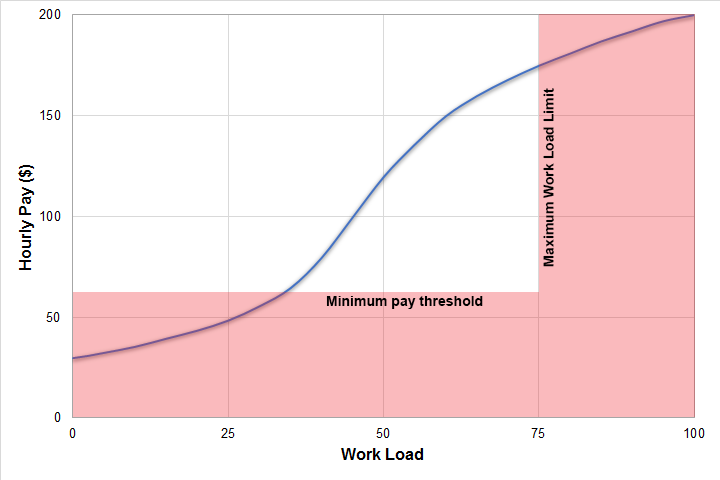I have a reputation among the residents and fellows at my hospital as being a moonlighting guru -- I think the reason is that they hear that I moonlight a lot, so they think I must know a lot about it! They often ask me for advice on how to get started and what I look for in a moonlighting gig, so I decided to write this post describing my thought process when evaluating a moonlighting gig.
Hourly Pay vs. Work Load
When evaluating a potential moonlighting job, there are certainly a lot of things to consider,but the initial screen for me is usually to evaluate the difficulty of the work as well as the hourly pay. Their relationship may look something like this:
This is just a representation of my perception of how one might fairly charge an hourly rate based on the workload, where zero is absolutely no work and 100 is constant work requiring working in overdrive during the entire shift. The relationship may not even be sigmoidal; this is just how it seems to me based on the pay I have seen. Depending on your expertise, your specialty, and whether you go through a moonlighting firm or not, what you consider a fair hourly pay may be different.
Eliminating undesirable options
The workload of a moonlighting position cannot be too strenuous. For one, I still carry a day job, so most of the moonlighting positions I take are night shifts. Thus, there must be the possibility of sleeping at least a few hours or, even better, the whole night. If not, I would not be able to function the next day. Secondly, repeated stressful shifts will lead to burnout, which is counterproductive in the long run. There is a workload limit past which I would not accept a job no matter what, because that is not what I want in a second job. Some may even look for the least amount of work possible, with the caveat that the pay rate usually increases with work load.
Excluding those who can only moonlight in internal positions with limited options, one may set a minimum hourly pay below which you would never accept. There is at least some minimum worth to your time that you would say maybe it is better you spend that time on something else. I have a number -- and I urge you to think about it as well.
Eliminating these areas (highlighted in red) would leave you a graph looking like this:
The areas highlighted in red include an amount of pay or amount of work that is unacceptable to me, and so I should choose not to pursue these. Now lets consider a few example jobs, labeled A-F, on the same graph:
A - The pay is quite high, and is actually above the line that I deem to be fair. However, the work load is more than I am willing to accept, so I will decline this one.
B - The workload is very low, and the pay is more than fair. However, if I value my time at say a minimum of $60/hr, then this will not make the cut. Pass.
C - This is outside of the red area of the graph, and thus under consideration. However, you will notice that it lies below the line at which I deem to be fair compensation for the amount of work done. Given better options, I would opt for other gigs before choosing this one.
D - The pay is good, and the amount of work is very low. This is an AMAZING gig. In fact, the further north of the line a job is, the easier it is for me to make the decision to take it.
E - The pay is even better than 'D', however the workload is significantly higher and about commensurate to the pay. Between D and E, one would have to consider whether pay is more important to you or work load. If possible, why not sign up for both and choose depending on your circumstances for that week or month?
Green Area - this is where you should ideally be narrowing down your options to, as the pay is at least commensurate with the workload, and sometimes even better. Choosing between the options in this area is where it gets down to the nitty gritty, which becomes highly personal.
Other factors to consider
1. Location
The decision between choosing a gig within walking distance of your house versus one that is 40 miles away may seem like an easy decision. What if the farther one pays $50 more per hour? This will depend on your transportation options and how willing you are to drive. Keep in mind that the hospitals in rural areas tend to require more coverage and will tend to pay more.
2. Work Environment
Do you desire to work in a small community hospital, or do you love working in an academic center? Intimidated about taking care of an ICU by yourself? What about caring for the entire hospital by yourself? Know what you are comfortable with and choose within that zone.
3. Hours
Often, moonlighting shifts are overnight; however, you can sometimes find daytime shifts, weekend day or night shifts, and even calls from home. Find what works with your schedule.
4. Payment type
I have had jobs that paid as a W2 employee, but most pay1099 income. I actively seek out 1099 income to increase my retirement account limits and provide some tax benefits.
Remember, moonlighting is a buyers market! You have the asset, and they want you! Diversify, find several options, and schedule them according to what works for you! Do not be afraid to decline a shift or job. Happy hunting!




